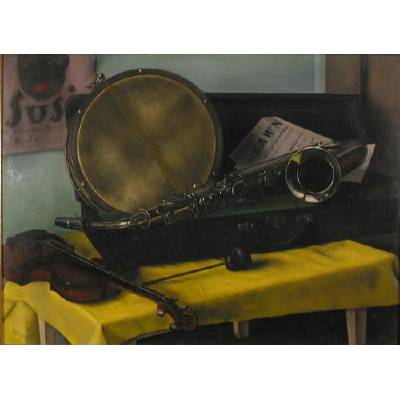
Title:Bathers
12.38″ x 19.13″ (31.45cm x 48.59cm)
Created: 1920 Oil/Masonite
Signed and Dated
Farhat Art Museum Collection
Louis Michel Eilshemius (1864–1941)
http://www.newyorkartworld.com/reviews/eilshemius.html
Biography
http://en.wikipedia.org/wiki/Louis_Eilshemius
Biography
He was a poet who painted like one, but his lyricism was not related to his time and expressed no definite period . . . One can hardly find words to define him. Eilshemius’ paintings speak for themselves.
Marcel Duchamp, artist
This phantasmagorical character was one of the best artists we have ever produced.
Clement Greenberg, art critic
About Eilshemius I want to go on record with you: He was the most poetic, lyrical, beautiful painter in America.
Joseph H. Hirshhorn, collector
In 1941, an anonymous writer for The New York Times reported that “Louis Eilshemius seems more like a character invented by Poe or Hawthorne than an actual person.” Indeed, Eilshemius’s eccentric behavior, self-professed genius, and, above all, visionary art created a persona interlaced with mystery like that of his contemporary Ralph Albert Blakelock. Although he would die in the Bellevue Psychiatric Ward in 1941, Eilshemius was borne into a sophisticated and wealthy family. His father’s fortune as a successful businessman provided the young Eilshemius with the opportunity to travel widely and attend prominent international schools such as the Handelsschule in Dresden. The burgeoning artist returned to the United States to enroll at Cornell University where he took courses in agriculture; however, this area of study did not afford him the expressive freedom found in art. Eventually, Eilshemius’s hesitant father gave way and allowed his son to devote his life to his chosen profession.
While Eilshemius’s well-known landscapes and bather scenes suggest he was a “primitive” as touted by periodicals of the 1900s, he was in fact a well-trained and talented academic artist. He attended multiple schools including the Art Student’s League in New York and the Académie Julian in Paris, reportedly studying with Bouguereau. Early sketches such Standing Female Nude, Hand on Hip (c. 1887; Hirschhorn Museum and Sculpture Garden) showcase his ability to draw naturalistic figures following the conventions of mid to late nineteenth-century American art. Nevertheless, the individualistic artist forged his own path, creating mystical landscapes and figural scenes that bared comparison to those of Arthur B. Davies.
Eilshemius found middling success in his earlier years, exhibiting at the Pennsylvania Academy of the Fine Arts and the National Academy of Design. It was not until 1917 that he was truly recognized. “Discovered” and promoted by the equally provocative Marcel Duchamp who saw the American artist’s submission to the 1917 Independents Exhibition, Eilshemius was almost instantaneously heralded as “an artist of genuine poetic power.” Duchamp’s enthusiasm led to two solo exhibitions of Eilshemius’s work, one of which was held at the Société Anonyme in 1920.
Strangely, in 1921, Eilshemius gave up painting, perhaps annoyed by what he viewed as his late reception into the established art circles of New York. Nevertheless, he continued to be a vital force in the visual arts, penning innumerable editorials published in The New York Sun and The New York Times. By the 1930s he was a favorite of collectors including Louis Kaufman, Roy R. Neuberger, and Joseph H. Hirshhorn, whose collection of nearly 230 Eilshemius’s remain at the Hirshhorn Museum and Sculpture Garden to this day. Modernist Milton Avery was also taken with Eilshemius’s work for its “poetic quality,” as was Louise Nevelson and musician George Gershwin who were avid Eilshemius collectors.
Catastrophe struck in 1932 when Eilshemius was struck by a car, confined to his Park Avenue brownstone, and descended into abject poverty. All the while, his art took the New York scene by storm and was the subject of no fewer than twenty-five solo exhibitions between the time of his accident and his death in 1941. His legacy continued thereafter as the exemplar of a true American original. Eilshemius’s oeuvre continues to be the subject of exhibitions including a 2001 show at the National Academy of Design proposed by contemporary artist Paul Resika. The artist’s works are included in the collection of nearly every major museum including The Metropolitan Museum of Art, Museum of Modern Art, Brooklyn Museum of Art, Philadelphia Museum of Art, The Phillips Collection, Fine Arts Museums of San Francisco, Cleveland Museum of Art, and of course, the Hirshhorn Museum and Sculpture Garden.
JLW





